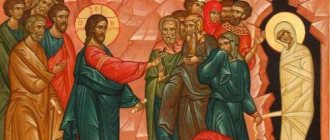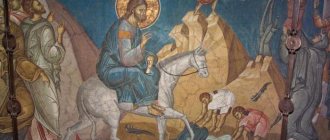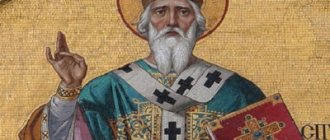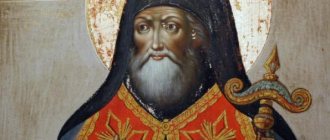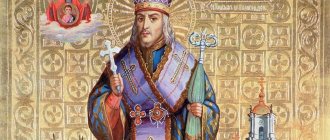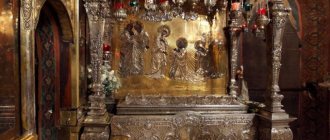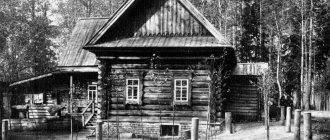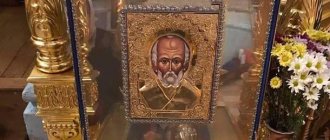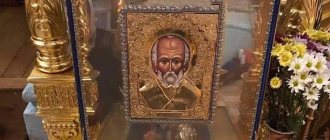Resurrection of rights. Lazarus. Mosaic c. Sant'Apollinare Nuovo in Ravenna. 526
In 2022, almost 60 million people died on our planet. Death is an insensitive monster that knows no mercy or mercy. She seems omnipresent and invincible. But the Bible says that death will be crushed forever. And these are not the dreams of naive ancient idealists. The proof of God's victory over death is the resurrection of Lazarus.
Summary of the Gospel Narrative
Lazarus, a close friend of Jesus Christ , lived with the sisters Martha and Mary, who also believed in the Lord. Their home was located not far from Jerusalem in Bethany. Jesus stayed with them several times.
John 11 reports the illness of Lazarus. His sisters sent their friend to report their brother's illness to Christ. Jesus, having learned about the death of his friend, went to Bethany, telling his disciples that he had fallen asleep. When the apostles did not understand, He clarified: “Lazarus died.”
Coming to Martha and Mary, He saw their grief and burst into tears Himself. But he immediately encouraged them with the hope of the resurrection from the dead. Christ commanded that the stone be rolled away from the tomb and
“And this river cried with a great voice: Lazarus, come out.”
(John 11:41-43).
The news of this event spread like lightning. Many people from all over the area came to see Lazarus. But the enemies of Christ wanted to destroy the living proof of Jesus' messiahship.
Soulful teaching on Lazarus Saturday
Wanting to spiritually strengthen His disciples before the coming suffering on the cross, the Lord performed a greatest and hitherto unprecedented miracle, for neither He Himself nor the former saints before Him had ever before that day raised from the dead the bodies of people who had already begun to decompose over time. The Resurrection of Lazarus has a prototype of both the soon to follow Resurrection of Christ and the general Resurrection for all people, which will appear at the end of the world. St. John Chrysostom reveals the spiritual meaning of this wonderful and above natural event, clearly showing the Divine dignity of the Savior:
This is the radiant forerunner of the triumph of Christ's Resurrection. Behold the memory of Lazarev, showing the miracles of Christ. The image of this four-day resurrection of Lazarus bears the fruits of the three-day Resurrection of Christ. This Lazarus appeared as the second forerunner to those sitting in darkness. This first enemy was the death of hell. Today Christ fulfill His miracles throughout the world. Today Christ destroys the power of death, raises up Lazarus of four days, prefiguring His Resurrection (“Chrysostom”, verse 58).
“The loud voice of the Savior, who raised Lazarus, serves as an image of the great trumpet that will sound on the General Resurrection” (Blessed Theophylact of Bulgaria) [].
Blessed Theophylact of Bulgaria, in his interpretation of the Gospel of John, bewilderedly condemns the Jewish leaders, since they, blinded by insane envy, for the sake of the former miracle of the resurrection from the dead, are finally deciding to betray Christ the Savior to death. He also notes their insidious cunning: in order to justify themselves, the priests spread rumors among the people about an allegedly impending danger from the Romans, who, for the sake of multiplying miracles, could suspect the entire Jewish people of political unreliability. They decided to kill the resurrected Lazarus at the same time in order to atone for the memory of the past miracle, which was especially annoying to them also because it happened on the eve of a great holiday and thus served to further the glory of the Son of God they hated. Having learned about this, Lazar was forced to flee and hide in Cyprus. As it is written in the Synaxarion of the Colored Triodion, after being in the tomb he could no longer eat ordinary food, “except for the delightful”; He had the saint’s omophorion as a gift from the Most Pure Mother of God: “Having created his omophorion, the Most Pure Mother of God with Her own hands, it was given to him.”
Of all four evangelists, only one John the Theologian talks about the resurrection of Lazarus, since at the time when the other apostles wrote, St. Lazarus was still alive. St. ap. John accurately reveals both the Divine and human nature of the Lord, for we see Him not only autocratically approaching the laws of nature, but also asking about the burial place of Lazarus and shedding tears of compassion.
John, compared with other evangelists, proclaims the highest teaching about the Lord and great theologizes; therefore, from His bodily deeds he tells about those who are more humble. Therefore, in the Lord’s sorrow he finds much that is human and thereby proves the truth of his flesh, so that you may know that the Lord was God and at the same time Man [].
As you know, Holy Scripture also has an allegorical meaning, therefore Bl. Theophylact gives us another interpretation to explain the miraculous event, as we can perceive it in relation to ourselves:
Understand, perhaps, this is a miracle in relation to the inner man. Our mind is a friend of Christ, but is often overcome by the weakness of human nature, falls in sin and dies a spiritual and most pitiful death, but on the part of Christ it is rewarded with regret, for the deceased is His friend. Let the sisters and relatives of the deceased mind, like Martha (for Martha is more corporeal and more substantial), and the soul, like Mary (for Mary is more pious and reverent), come to Christ and fall before Him, leading with them the thoughts of confession, like those of the Jews. For Jude means confession. And the Lord, without a doubt, will appear at the grave, the blindness lying in the memory will command to be taken away, as if some stone, and will bring future blessings and torment to memory. And he will cry with the great voice of the gospel trumpet: get out of the world and do not bury yourself in worldly amusements and passions, and thus will resurrect from sin the deceased, whose wounds smelled of malice. The deceased gave off a smell because he was four days old, that is, he died for the four meek and bright virtues and was idle and motionless towards them. However, although he was motionless and bound hand and foot, he was compressed by the knots of his own sins and seemed completely inactive, although his face was covered with a scarf, so that when the fleshly veil was applied he could not see anything divine, but he would hear: untie him, kind and angels or priests serving salvation and give him forgiveness of sins, let him go and begin to do good [].
Interpretation: The Theological Meaning of a Supernatural Event
The first thing that stands out is the amazing behavior of Jesus. Hearing about his friend’s illness, He did not rush to help, but set off on the journey only 2 days later.
Interesting fact
Jesus could have healed Lazarus from a distance. So he cured the son of a royal servant from Capernaum, while in Cana in Galilee, and the servant of a Roman centurion.
However, surprisingly, Jesus chose not to heal his close friend with just a word. Moreover, He knowingly allowed Lazarus to die. To some, the Lord's behavior may seem illogical or even cruel. But He pursued the highest goal - strengthening people's faith in the power of God, capable of defeating even death.
The Resurrection of Lazarus (icon, 12th century, St. Catherine's Monastery)
Therefore, when the Lord went with his disciples to Bethany, he experienced spiritual uplift:
Then Jesus said to them plainly: Lazarus is dead; and I rejoice for you that I was not there, so that you might believe; but let's go to him.
(John 11:14, 15)
This episode can be spiritually beneficial if viewed from different perspectives:
- God's attitude towards death and suffering of people;
- strengthening faith in the resurrection of the dead.
Many people believe that God is a completely indifferent Ruler of the Universe who enjoys life without paying attention to our problems. Still: who are we for Him to think about us?
I was grieved in spirit
But the behavior of Christ clearly refutes this idle idea of God. The joy He experienced during the journey with the apostles to Bethany quickly disappeared when Jesus saw the grief of Lazarus’s loved ones:
When Jesus saw her weeping and the Jews who came with her weeping, He Himself was grieved in spirit and indignant
(John 11:33)
But what does “grieved and indignant” mean? Some believe that the Lord was perplexed because of the Jews' lack of faith in His ability to bring the dead back to life. And this is after all the miracles that He performed! And it would be fine if only the friends and relatives who came to support Lazarus’ family were crying, but even Martha and Mary were heartbroken.
How can one not be outraged? Some believers, based on this interpretation of the biblical text, came to the conclusion that we should not grieve and cry if our relatives and friends die. This is supposedly a manifestation of weak faith.
Lazarus with his sisters Martha and Mary. Unknown Spanish artist. First quarter of the 16th century
But is this idea true? Could Jesus experience real intense sadness, or was He an embodiment of pure reason, incapable of any human emotion?
For most pagans, compassionate gods are nonsense. And some Greek philosophers came to the conclusion that the Lord of the Universe is completely independent of His creation. But if He is capable of joy, sadness or compassion, then this means that He is subject to influence from without and the creation has a certain amount of power over Him. But no one can rule over God. Therefore, it is logical to conclude that He is not capable of any emotions: neither positive nor negative.
Particularly striking to the Greeks were the words that Jesus shed tears. But the entire biblical context suggests that God is not the dispassionate ideal of the Greek Stoics. Our joy, sorrow, despondency and delight, love and compassion are not a manifestation of the sinful nature, but a reflection of the perfect Divine personality. We are created in His image and likeness (Genesis 1:26), so we have every right to sadness and joy, love and compassion. It is completely natural to cry and lament at a funeral.
“Christ contemplated all the terrible meaning of death, this sinful rent. All the misfortunes of mankind were revealed before His eyes in the small form of one man. He saw before Him all the mourners and all the graves. For if He was ready to wipe away the tears of his upcoming friends and for a short time turn their sadness into joy, this would not change the state of things, in essence: Lazarus will be revived, but will soon taste the bitterness of death a second time.”
Trench coat “Miracles of Jesus Christ”
Yes, Jesus was shaken to the core by the great pain that death brought to our world. God's compassion is very important to us. If God does not put an end to the world's evil, then he cannot be truly happy. Yes, feelings make Him vulnerable and dependent on our behavior. But it is thanks to them that we were born and have the opportunity to live forever.
The resurrection of Lazarus is not an invention of early Christians: evidence
Now let's discuss one of the main miracles performed by Jesus. Can we believe that He actually brought Lazarus back to life or is this nothing more than an invention of the early Christians? There are several proofs of the reliability of the gospel message:
- First-century Jews understood medicine and could not mistake the resurrection of Lazarus a few days after his death for an awakening from a lethargic sleep.
- There was a foul smell of decay coming from the cave in which Lazarus was buried, a clear indication that he was dead.
- The enemies of Christ wanted to kill Lazarus, which proves the authenticity of his resurrection. Suspicious and picky scribes, Pharisees and Sadducees could easily expose the trick with the revived friend of Jesus.
The most important thing is the reason why Jesus raised his friend. What did he want to show by this? The resurrection of Lazarus is one of the strongest proofs that we have hope for the future.
The people recognized it, but the bishops were indignant, turning the miracle performed into a reason for hatred. They really hated the resurrection of Lazarus, because after the resurrection you heard about, they decided to kill him. Do you see the excess of hatred? They plotted to kill the one whom the Lord had raised, because they did not understand that even if they killed him, it would not be difficult for the Lord to resurrect his friend again. They conspired to kill Lazarus, because nothing offended the Jews more than the resurrection of Lazarus. Only they could not slander this miracle. They slandered the healing of the man born blind, saying: This is he. It's not him. Looks like him (John 9:9).
They slandered the resurrection of Jairus's daughter, saying that she was in deep sleep and was not completely put to death. They slandered the resurrection of the widow's only son, saying that he only took upon himself the appearance of death and was not swallowed up by the power of death. They slandered the miracle of the withered fig tree, saying that it withered because of the poverty of the soil, and not according to the word of the Lord. They slandered the transformation of water into wine, saying that it was a joke on those who were already drunk at the feast and felt nothing. Only they could not slander the resurrection of Lazarus.
Amphilochius of Iconium
For thousands of years, death has caused incredible suffering to humanity. It destroys the lives of individuals, destroys families and destroys entire worlds. Despite all the achievements of scientific and technological progress, people have not been able to achieve eternal youth and life.
Zombie?
Only God can do this. Jesus showed that he is the Lord of both life and death. Nowadays, as in ancient times, people believe that bringing the dead back to life is an impossible dream. In numerous films and TV series, those who have returned to life are presented as zombies - the walking dead, not even aware of their existence.
Right Lazarus. Painting c. Spasa on Nereditsa. 1199
But Lazarus was not a zombie. He returned the same person he was before his death. He didn't just look like the old Lazarus. He returned completely, with all the individual traits of his personality.
The resurrection of Lazarus is the fate of all people who have gone through death. God does not perceive it as something natural. For Him, as for us, death is not a friend:
The last enemy to be destroyed is death.
(1 Corinthians 15:26)
But the resurrection from the dead is a problem not only for non-believers, but also for many Christians. After all, most often, when thinking about future eternity, Christ’s disciples imagine life as an immortal soul and nothing more. The body is not given any importance. But both the Holy Scriptures and the works of the Church Fathers refute the generally accepted idea of eternal life in the form of a cheerful ride of the soul on a cloud.
Entrance to the burial chamber of Lazarus in Bethany
In its pure form, this idea was characteristic of pagan philosophers such as Socrates and Plato. Scripture teaches otherwise. Resurrection is not the separation of the soul from the body, but the complete restoration of our organism. According to the teachings of the Church, the soul will reunite with the body.
But, unlike Lazarus, the bodies of the righteous resurrected at the Second Coming of Christ will become perfect and immortal. Of course, Lazarus will also be brought back to life. A second time. And this time he won't die.
Resurrection
Jesus had never been in such a position before. Very often performing miracles, He performed them, one might say, casually. And the more amazing they were, the less He collected witnesses for them and even sometimes forbade talking about them.
But now He had to perform the greatest miracle in front of a multitude of people. The beneficial impression from the previous miracles of Jesus could weaken over time, obscured by evil gossip spread by His opponents. On the other hand, the friends and admirers of Jesus were soon faced with the greatest temptation—His approaching suffering and death on the cross. Jesus knew that within just a few days He would die. How will His disciples take this? Won't they lose heart? Will they not disbelieve everything that He taught them for three years? Therefore, Jesus wanted to give his disciples a strong foundation of faith and a guarantee of hope that all things are possible with the Son of God. A tense silence hung in the air. The stone was rolled away, the black opening of the burial cave gaped like the mouth of some monster that had devoured Lazarus four days ago. And there was a crowd of Jews standing around, waiting to see what would happen next.
Jesus raised his eyes to heaven and said:
- Father! I thank You that You heard Me. I knew that You would always hear Me; but I said this for the sake of the people standing here, so that they might believe that it was You who sent Me.
Having said this, he called out in a loud voice:
- Lazarus! get out.
Sounds were heard from the tomb, as if someone was moving there. A moment later, the deceased Lazarus came out from there, wrapped in burial shrouds on his arms and legs, with his face bandaged with a scarf. Everyone present gasped and recoiled at this incredible sight. Horror and joyful admiration alternated between each other on their faces. Jesus turned to the astonished Jews and said:
- Untie him, let him go.
After this, many of the Jews who came to Mary and saw what Jesus had done believed in Him. And now popular rumor bears testimony to what happened from house to house, from village to village throughout the land of Judea. The history of their people carefully preserves cases when great prophets raised the dead. But no one has yet been able to resurrect a four-day old, already stinking corpse. Not otherwise, this Galilean preacher is truly the Son of God!
And at the same time, the Jewish high priests gathered for a council, deciding to kill along with Jesus Lazarus, whom He had resurrected...
***
Everyone went their own way in those days. Lazarus had to escape the insidious plan of the Jews, flee to the island of Cyprus, become a bishop there and die again in old age. Jesus walked towards suffering, death on the cross and the eternal glory of His Resurrection. His enemies are to the same eternal shame. Easter was approaching.
Take our short test and find out how well you remember the story of one of the most famous miracles of Jesus Christ - the resurrection of Lazarus!
Quiz
Test: How well do you remember the gospel story of Lazarus, Jesus' friend?
Start Quiz
Where was Lazarus, Jesus' friend, from?
From Jerusalem
From Capernaum
From Bethany
From Nazareth
Lazarus was born in Bethany. Christ stayed in this city on the eve of his triumphal entry into Jerusalem, and there the Savior performed a well-known miracle - he resurrected his friend.
Lazarus was born in Bethany. Christ stayed in this city on the eve of his triumphal entry into Jerusalem, and there the Savior performed a well-known miracle - he resurrected his friend.
Lazarus was born in Bethany. Christ stayed in this city on the eve of his triumphal entry into Jerusalem, and there the Savior performed a well-known miracle - he resurrected his friend.
Lazarus was born in Bethany. Christ stayed in this city on the eve of his triumphal entry into Jerusalem, and there the Savior performed a well-known miracle - he resurrected his friend.
What were the names of Lazarus' sisters?
Sarah and Hagar
Anna and Rachel
Eve and Judith
Martha and Mary
Martha and Mary are the sisters of Lazarus and are one of the most famous characters in the New Testament. Jesus Christ stayed in the house of these sisters. Both women witnessed the resurrection of their brother, performed by Christ at their request.
Martha and Mary are the sisters of Lazarus and are one of the most famous characters in the New Testament. Jesus Christ stayed in the house of these sisters. Both women witnessed the resurrection of their brother, performed by Christ at their request.
Martha and Mary are the sisters of Lazarus and are one of the most famous characters in the New Testament. Jesus Christ stayed in the house of these sisters. Both women witnessed the resurrection of their brother, performed by Christ at their request.
Martha and Mary are the sisters of Lazarus and are one of the most famous characters in the New Testament. Jesus Christ stayed in the house of these sisters. Both women witnessed the resurrection of their brother, performed by Christ at their request.
Where was Lazarus buried?
In the Jerusalem Temple
In a cave
On the shore of Lake Gennesaret
At the top of the Mount of Olives
Lazarus was buried in a cave according to Jewish custom. The entrance to the cave was covered with a large stone: “they took the stone away from the cave where the deceased lay. Jesus raised his eyes to heaven and said: Father! I thank You that You heard Me. I knew that You would always hear Me; but I said this for the sake of the people standing here, so that they might believe that You sent Me. Having said this, He cried out with a loud voice: Lazarus! get out. And the dead man came out, entwined on his hands and feet with burial cloths, and his face was tied with a scarf. Jesus says to them: Untie him, let him go” (Gospel of John, chapter 11).
Lazarus was buried in a cave according to Jewish custom. The entrance to the cave was covered with a large stone: “they took the stone away from the cave where the deceased lay. Jesus raised his eyes to heaven and said: Father! I thank You that You heard Me. I knew that You would always hear Me; but I said this for the sake of the people standing here, so that they might believe that You sent Me. Having said this, He cried out with a loud voice: Lazarus! get out. And the dead man came out, entwined on his hands and feet with burial cloths, and his face was tied with a scarf. Jesus says to them: Untie him, let him go” (Gospel of John, chapter 11).
Lazarus was buried in a cave according to Jewish custom. The entrance to the cave was covered with a large stone: “they took the stone away from the cave where the deceased lay. Jesus raised his eyes to heaven and said: Father! I thank You that You heard Me. I knew that You would always hear Me; but I said this for the sake of the people standing here, so that they might believe that You sent Me. Having said this, He cried out with a loud voice: Lazarus! get out. And the dead man came out, entwined on his hands and feet with burial cloths, and his face was tied with a scarf. Jesus says to them: Untie him, let him go” (Gospel of John, chapter 11).
Lazarus was buried in a cave according to Jewish custom. The entrance to the cave was covered with a large stone: “they took the stone away from the cave where the deceased lay. Jesus raised his eyes to heaven and said: Father! I thank You that You heard Me. I knew that You would always hear Me; but I said this for the sake of the people standing here, so that they might believe that You sent Me. Having said this, He cried out with a loud voice: Lazarus! get out. And the dead man came out, entwined on his hands and feet with burial cloths, and his face was tied with a scarf. Jesus says to them: Untie him, let him go” (Gospel of John, chapter 11).
How many days had Lazarus been dead when Christ came to him to resurrect him?
a week
Month
Three days
Four days
Lazarus of Bethany is also called Lazarus the Four Days (“Jesus came and found him already four days in the tomb”).
Lazarus of Bethany is also called Lazarus the Four Days (“Jesus came and found him already four days in the tomb”).
Lazarus of Bethany is also called Lazarus the Four Days (“Jesus came and found him already four days in the tomb”).
Lazarus of Bethany is also called Lazarus the Four Days (“Jesus came and found him already four days in the tomb”).
What is the future fate of Lazarus?
Preached Christianity in India and China
Became a bishop in Cyprus and died in old age
He was executed in 80, during the reign of the Roman Emperor Titus.
Became a preacher in Thessalonica and resurrected a little boy who died from a snake bite
After the Resurrection of Christ, Lazarus was forced due to persecution to leave Judea and move to Cyprus. He served as bishop there for 18 years. After his resurrection, he lived for another thirty years, and then died a second time in Cyprus in 63.
After the Resurrection of Christ, Lazarus was forced due to persecution to leave Judea and move to Cyprus. He served as bishop there for 18 years. After his resurrection, he lived for another thirty years, and then died a second time in Cyprus in 63.
After the Resurrection of Christ, Lazarus was forced due to persecution to leave Judea and move to Cyprus. He served as bishop there for 18 years. After his resurrection, he lived for another thirty years, and then died a second time in Cyprus in 63.
After the Resurrection of Christ, Lazarus was forced due to persecution to leave Judea and move to Cyprus. He served as bishop there for 18 years. After his resurrection, he lived for another thirty years, and then died a second time in Cyprus in 63.
Quiz
Be careful!
Our article about this famous miracle of Christ is very short, but very significant for the entire gospel history. We advise you to re-read it again!
A little bit lacking in attentiveness!
Looks like you missed some of our material! No problem, next time you will score maximum points!
Attentive reader!
Humanity still remembers the miracles of Christ, although two thousand years have passed since that time. You answered all our questions correctly! Congratulations!
Share the result:
What Church Tradition says
In Tradition there are 2 versions of what happened to the righteous man next: Cypriot and French.
The life of Lazarus the Four Days after the resurrection
According to the Cypriot version, the Pharisees were so angry with Jesus that Lazarus had to go to Cyprus to avoid being killed. In his new place, he became the first bishop of the Christian congregation. Paul and Barnabas ordained him. In Cyprus, Lazarus, according to this version, served for 18 years.
The French version of the Tradition says that Lazarus was expelled from Israel along with Martha and Mary. The Pharisees put them in a boat that had no sails or sails. and sent to the open sea. But the saints managed to reach French soil. In Marseilles, Lazarus became a bishop, and then died as a result of the persecution of Christians in the second half of the 1st century. He was buried in this city.
Veneration of Righteous Lazarus in Cyprus and Russia
One of the most revered places in Cyprus is the Church of St. Lazarus in the city of Larnaca. About a week before Easter, believers take to the streets with an icon of Lazarus, which they carry through the streets.
In Russia, the righteous man also enjoys great respect. In his honor, services are held and sermons are read.
Reliquary with head of rights. Lazarus in the center right Lazarus in Larnaca, Cyprus
Where are the relics located?
On the territory of Cyprus, the burial was lost in the 7th century. After 200 years it was found again. On the tombstone there was an inscription: “Lazarus of the Fourth Day, friend of Christ.” After this, the relics were sent to Constantinople, but part of them remained in Cyprus. They were discovered in the 70s of the 20th century during renovations in the temple. Nowadays, the relics are displayed for veneration in the center of the church building not far from the icon depicting Lazarus.
History of the temple of Larnaca (Cyprus)
Before the island became part of the Ottoman Empire in 1570, the church belonged to Catholics. Then it became a mosque, and in 1589 the building was bought by the Orthodox Church.
Tomb of Righteous Lazarus in the Church of St. Lazarus in Larnaca.
In Cyprus, there is a tradition of bringing wax figures of people and body parts to the temple - to the burial place and the icon of Lazarus. The church building is made of heavy stone blocks. It was rebuilt many times. There is a museum there where you can learn the history of the temple. Here you can see the image of the righteous man, created in the 12th century.
Church of the Resurrection of Lazarus Kizhi
Kizhi is an island in Karelia. The local church was founded around the 14th - 15th centuries. Here you can hear artistic bell ringing. The church is the oldest monument of wooden architecture in the northwestern part of our country.
The Church of the Resurrection of Lazarus was part of a monastery founded in the 14th century by Lazarus of Murom . In the 20th century, during the Soviet era, it was transported to the island of Kizhi.
The Raising of Lazarus. Divine service
Lazarus Saturday is also called “Little Easter”: this is indicated by the corresponding liturgical texts and some features of the charter that are characteristic only for this day. Thus, on Friday at Matins, before the reading of the canon, “The Sunday of Christ has been seen” is sung, which corresponds to the rite of the Sunday service; the festive troparion is common for two holidays, for Saturday itself and for the Flower Sunday that follows. The last stichera before the Great Doxology alternate with Sunday verses; at the end the Sunday stichera “ Blessed are you the Virgin Mary ” is sung. From this day the service of the Triodion of Color , the books of oktai and menaion are lowered to the week of St. Apostle Thomas.
Troparion, tone 1.
The general resurrection is before its passions, and 3z8 of the dead are raised lazarz xrte b9e. Moreover, we, too, are young people, victorious in our image, we cry out to you, the conqueror of death, Hanna in the Lord, blessed city in 0 and 3 mz.
Kontakion, tone 7.
And the joy of all is the truth, the light and the living, and the joy of peace that exists on the earth2 kvi1sz. with your goodness, bhv o4braz waxRseniz. and3 a divine arrangement was given to everyone.
The canon for the holiday at the Vespers was compiled by St. Andrew of Crete , at Matins - St. Theophanes the Songwriter .
Library of the Russian Faith Canon for Lazarus Saturday →
Read online
Icons
The iconography of Lazarus appeared in very ancient times (VI-VII centuries). Since then, it has not undergone significant changes. Christ is shown standing near the tomb of Lazarus. At the feet of the Lord are Mary and Martha, begging Him for the return of their brother.
The Raising of Lazarus. Byzantine icon. The end of the 14th - beginning of the 15th century. State Russian Museum
The icon also shows the Jews who came to see the manifestation of God's great power. The smell of decay emanates from the tomb, so people cover their noses with a handkerchief. The back entrance to the cave is a symbol of the grave and death.
The resurrection of Lazarus also inspired other artists. Some of these paintings have become internationally recognized masterpieces.
The Raising of Lazarus. Painting
The Gospel story of the Raising of Lazarus has repeatedly become one of the popular themes of paintings by famous artists. Thus, such painters as Giotto, Caravaggio, Guercino, Albert van Ouwater, Rembrandt Harmens van Rijn, Vincent van Gogh, M.V. depicted the Resurrection of Lazarus on their canvases. Nesterov.
Fragment of Giotto's fresco "The Raising of Lazarus". Written in 1304-1306
"The Raising of Lazarus" by Albert van Ouwater. Written around 1450
Caravaggio "The Raising of Lazarus" 1608-1609.
Guercino. The Raising of Lazarus. 1619 Louvre, Paris, France
Rembrandt Harmens van Rijn "The Raising of Lazarus". 1630
Vincent Van Gogh. The Raising of Lazarus. 1890
M. V. Nesterov. The Raising of Lazarus. 1899-1900 Sketch for the painting of the northern wall of the Church of St. Alexander Nevsky in Abastumani. State Russian Museum, St. Petersburg
The image of Lazarus in the paintings of artists
Already during the period when Christians met for worship in the catacombs, believing artists painted their favorite story of the resurrection of Lazarus on their walls. About 40 such images have survived to this day.
Rembrandt
The Dutch artist created the painting between 1630-1632. The painting shows the moment when Lazarus woke up from his mortal sleep and began to rise from the grave at the command of Jesus. All those gathered, except Christ, are extremely amazed at what is happening.
Rembrandt. The Raising of Lazarus. 1630—1632 Wood, oil. 96.36 × 81.28 cm Los Angeles County Museum of Art, USA
Caravaggio
The painter created the canvas about a year before his death. The dark background of the painting indicates a powerful and enormous emptiness. Light falls on the figures of the characters, opposed to nothingness. Lazarus is carried by gravediggers, who have turned away so as not to see the horror of death. But the Lord’s friend is already returning to life, as indicated by the movement of his hands.
Another Lazarus: the parable of the rich man and the poor Lazarus
Chapter 16 of the Gospel of Luke contains the Parable of the Rich Man and Lazarus. Lazarus was a poor and very sick man who suffered from leprosy. A burning feeling of hunger exhausted him constantly. Lazarus was sitting next to the house of a rich man whose name is not given. The rich man feasted every day, but never shared even the crumbs from his table with poor Lazarus.
After his death, Lazarus fell into the bosom of Abraham, and the rich man ended up in hell, where he suffered from unbearable flames. He begged Abraham to send Lazarus to his family to encourage him to repent. But Abraham answered him that if these people did not listen to Moses (the Law), then even the resurrected dead would not help them.
Lazar (Fyodor Bronnikov, 1886)
To correctly understand this passage, it is worth remembering that it describes images, not an afterlife reality. God does not torture sinners in hell with literal fire. Christ only wanted to show that for God, who will judge all humanity, the social and material situation of a person will mean nothing. The rich man suffered because of his indifference to the needs of his poor brothers.
You should not think that Lazarus from the parable is somehow connected with the real friend of Jesus. The name Lazarus was very common in those days. But after the return of Lazarus from the world of the dead, the words from the parable were confirmed that people drowned in the swamp of wickedness will not be able to repent, even if they see the resurrection of the dead.
What does Saint Lazarus help with?
Believers go on a long journey to be able to touch his relics and receive healing there. You can pray at the icon in the temple or purchase it and pray at home. The Lord healed him, and he, as God’s helper, helps those who ask, restores strength and health.
- The saint helps the seriously ill who cannot walk to get back on their feet. They pray for a long time and ask him for help. They get to his tomb crawling, on all fours, as best they can.
- Those suffering from skin diseases are completely cured.
- STD patients come to him, pray, and he prolongs their lives.
- There are cases where asthma patients were healed and relapses did not recur.
- They pray to him in despondency, and he suggests a way out of the current situation.
On the day of his resurrection, on Lazarus Saturday, they make vows that they try not to break for anything in life.
If suddenly a misfortune happens to you and the doctors are powerless, pray to Lazarus. Do not despair. He will hear and heal.
***
The resurrection of Lazarus is not just an amazing part of the biblical story. This is the greatest miracle performed by Christ. Through him, the Creator gives the most reliable consolation to those who have lost their loved ones, and to everyone who will still be swallowed up by death - the great enemy of all earthly creations of God. The return of Lazarus proves that death itself will be swallowed up forever and will no longer be able to take away our dear and loved ones.
And I heard a loud voice from heaven, saying: Behold, the tabernacle of God is with men, and He will dwell with them; they will be His people, and God Himself with them will be their God. And God will wipe away every tear from their eyes, and there will be no more death; There will be no more crying, no crying, no pain, for the former things have passed away.
(Rev.21:3,4)
Victor Glebov
